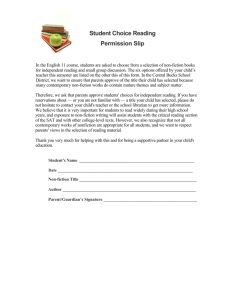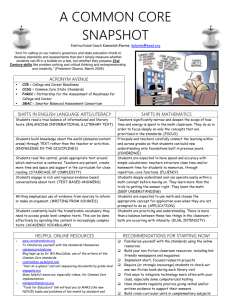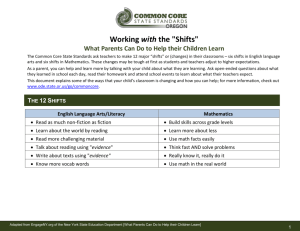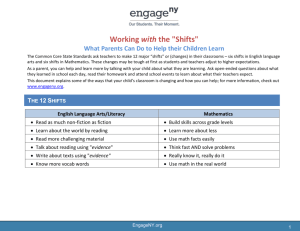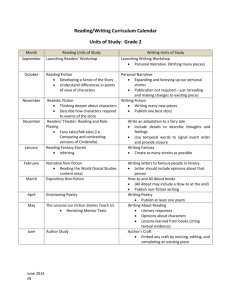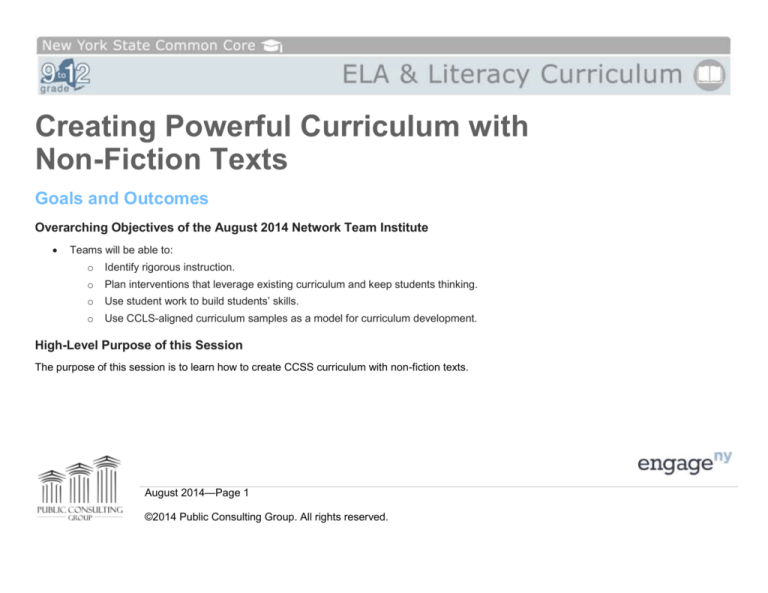
Creating Powerful Curriculum with
Non-Fiction Texts
Goals and Outcomes
Overarching Objectives of the August 2014 Network Team Institute
Teams will be able to:
o
Identify rigorous instruction.
o
Plan interventions that leverage existing curriculum and keep students thinking.
o
Use student work to build students’ skills.
o
Use CCLS-aligned curriculum samples as a model for curriculum development.
High-Level Purpose of this Session
The purpose of this session is to learn how to create CCSS curriculum with non-fiction texts.
August 2014—Page 1
©2014 Public Consulting Group. All rights reserved.
New York State Common Core
Related Learning Experiences
Setting the Stage: What is Rigor?
Maintaining Momentum and Correcting Course: Using Student Work to Improve Student Learning
Key Points
There are many different ways to approach the notion of “literary non-fiction.”
The CCSS requires a balance of fiction and non-fiction texts. ELA teachers have their own content and discipline-specific learning
objectives. Being able to understand nonfiction as a component of this content requires thinking about these types of texts in ways other
than as sources of “background information” for other fiction texts.
Students engage with the text as literature, worthy of investigation in its own right.
Session Outcomes
What do we want participants to be able to do as a result of this session?
Identify CCSS-aligned approaches to teaching non-fiction text.
August 2014—Page 2
©2014 Public Consulting Group. All rights reserved.
How will we know that they are able to do this?
Aligned survey question
New York State Common Core
Session Overview
Section
Introduction
Sampling the
Curriculum:
Experiencing CCSS
Non-Fiction
Sampling the
Curriculum:
Experiencing a
Lesson
Reflection and
Closing
Time
Overview
Introduce the session.
Prepared Resources
10 min
Session PowerPoint
Session PowerPoint
“Letter 1” from Rilke’s Letters
to a Young Poet
30 min
Participants read and annotate a
literary non-fiction text, answer
text-dependent questions, and
discuss supports for students.
30 min
Participants read a section of
9.1.2 Lesson 1 and analyze an
exemplar TDQ sequence.
Participants consider how nonfiction is treated in CCSS-aligned
curriculum.
Session PowerPoint
9.1.2 Lesson 1
5 min
Participants reflect on learning
and consider implications for
practice.
Session PowerPoint
75 min
Total for this session
August 2014—Page 3
©2014 Public Consulting Group. All rights reserved.
Facilitator Preparation
Position mic runners at
various spots around the
room for report out.
Position mic runners at
various spots around the
room for report out.
Position mic runners at
various spots around the
room for report out.
Position mic runners at
various spots around the
room for report out.
New York State Common Core
Session Roadmap
Section: Introduction
In this section, you will learn the purpose for this session.
Slide Time
1
Picture
0 min
Materials used include: Session PowerPoint
Script/Activity Directions
Welcome participants to the session.
August 2014—Page 4
©2014 Public Consulting Group. All rights reserved.
New York State Common Core
Slide Time
2
Picture
0 min
Script/Activity Directions
We will be live tweeting throughout the week! Follow us:
@EngageNY
@JohnKingNYSED
Join in the fun and use this hashtag: #NTIny.
3
3 min
Introduce the purpose of this session:
Explain how to teach non-fiction in a CCSS curriculum.
Describe how to maintain rigor when using non-fiction in classrooms.
August 2014—Page 5
©2014 Public Consulting Group. All rights reserved.
New York State Common Core
Slide Time
4
Picture
7 min
Script/Activity Directions
At their tables, participants discuss how non-fiction should function in a
CCSS ELA classroom.
(3 minutes)
Pull the group back together. Have participants discuss:
How is non-fiction text currently used in your school or district in ELA
classrooms? How should it be treated in a CCSS classroom?
(4 minutes)
Total
time:
10 min
August 2014—Page 6
©2014 Public Consulting Group. All rights reserved.
New York State Common Core
Section: Sampling the Curriculum: Experiencing CCSS Non-Fiction
In this section, you will read and annotate “Letter 1” from Rilke’s
Letters to a Young Poet, answer text-dependent questions, and
discuss supports for students.
Materials used include: Session PowerPoint, “Letter 1” from Rilke’s Letters to a
Young Poet
Slide
Time
Script/Activity Directions
5
8 min
Picture
Review shift 1 and 2 and discuss in groups:
What does each shift mean for classroom instruction and curriculum?
Lead a brief report out, making sure the following points are made:
Shift 1 necessitates students reading a balance of informaitonal and
literary texts, the latter of which can include both fiction and literary nonfiction.
Shift 2 asks that students build knowledge of the world through text.
This means we need to provide students with a range of texts and text
types in order to ensure they are exposed to the different types of texts
they’ll be faced with in college and careers. Additionally, students
should have practice using their literary interpretive skills with both
fiction and non-fiction texts.
August 2014—Page 7
©2014 Public Consulting Group. All rights reserved.
New York State Common Core
Slide
Time
6
22
min
Total
time:
Picture
Script/Activity Directions
Participants read “Letter 1” from Rilke’s Letters to a Young Poet.
In small groups, participants analyze a portion of the text using questions from
the curriculum as a guide.
30
min
Section: Sampling the Curriculum: Experiencing a Lesson
In this section, you will read a section 9.1.2 Lesson 1, analyze an
exemplar TDQ sequence, and consider how non-fiction is treated in
CCSS-aligned curriculum.
Materials used include: Session PowerPoint, 9.1.2 Lesson 1
August 2014—Page 8
©2014 Public Consulting Group. All rights reserved.
New York State Common Core
Slide
Time
7
15
min
Picture
Script/Activity Directions
Analysis of a Non-Fiction Lesson.
Ask participants to read a short section of an exemplar instructional sequence
from 9.1.2 Lesson 1. Participants will:
8
6 min
Read the lesson assessment and assessed standard.
Analyze how the series of questions scaffolds students towards the
expectations of the lesson assessment.
Non-Fiction and Rigor.
Pose the following questions to participants:
How does this non-fiction text (or other texts similar to it) fit into the HS
ELA curriculum?
What about it meets the Common Core’s standards for rigorous texts?
What are the implications for HS ELA text selection more broadly?
Lead a brief report out, making sure the following points are made:
In this unit, the non-fiction piece is used similarly to how a piece of fiction
might be used. It is read for word choice and theme, not “background.”
August 2014—Page 9
©2014 Public Consulting Group. All rights reserved.
New York State Common Core
Slide
Time
Picture
Script/Activity Directions
Students engage with the text as literature, worthy of investigation in its
own right.
It’s not a biography of an author, nor is it literary criticism.
As a piece of non-fiction, Letters to a Young Poet provides students an
alternative text type to grapple with and practice the skills embedded in
the standards.
Although it’s non-fiction, it provides just as rich a literary experience as a
strong piece of fiction. The vocabulary, concepts, knowledge demands,
and language/syntax are rich and grade-appropriate.
Non-fiction need not be bland informational text only; literary non-fiction
can be read as literature, providing students with opportunities to practice
their skills of text interepretation with non-fiction and fiction works alike.
Rigorous text selections are essential to providing rich text-based
experiences for students and to challenge them in the classroom.
August 2014—Page 10
©2014 Public Consulting Group. All rights reserved.
New York State Common Core
Slide
Time
9
2 min
Picture
Script/Activity Directions
Additional Non-Fiction in the EngageNY Modules.
Explain that the EngageNY curriculum modules provide multiple opportunities for
students to engage with different types of non-fiction texts, including:
“Letter from Birmingham Jail” by Martin Luther King, Jr. (10.2)
The Immortal Life of Henrietta Lacks by Rebecca Skloot (10.3)
“Hope, Despair and Memory” by Elie Wiesel (11.3)
The Autobiography of Malcolm X (12.1)
These non-fiction texts are embedded in research modules and in modules
alongside other fiction and non-fiction texts.
10
2 min
Additional Non-Fiction in the EngageNY Modules. (continued)
Explain that the curriculum also provides opportunities for students to read more
informationally-based non-fiction texts such as:
Animals in Translation by Temple Grandin (9.3)
Sugar Changed the World by Marc Aronson & Marina Budhos (9.4)
“The Universal Declaration of Human Rights” United Nations (10.2)
August 2014—Page 11
©2014 Public Consulting Group. All rights reserved.
New York State Common Core
Slide
Time
11
5 min
Picture
Script/Activity Directions
Discussion of Non-Fiction.
Ask participants to answer the following questions in groups:
Text brainstorm:
What other non-fiction texts might fit well in a HS ELA classroom?
Non-fiction in a CCSS curriculum:
What are some of the different ways non-fiction is used in a CCSS
curriculum?
How do we know if the way we’re teaching non-fiction is enacting the
instructional shifts?
Lead a brief report out, making sure the following points are made:
Non-fiction may be embedded in research modules as springboards for
inquiry-based, self-guided research. They may also be embedded in
modules alongside other fiction and non-fiction texts, providing
opportunities for students to contrast concepts, ideas, and linguistic styles
across authors and text types.
Non-fiction is in service of the instructional shifts if it is used to:
1) Achieve a balance of texts.
2) Expose students to ideas and literary/artistic concepts and
information in a way that broadens their experiences and
knowledge base beyond what they might experience with fiction
alone.
August 2014—Page 12
©2014 Public Consulting Group. All rights reserved.
New York State Common Core
Slide
Time
Total
time:
30
min
Picture
Script/Activity Directions
Section: Reflection and Closing
In this section, you will reflect on your learning from this session and Materials used include: Session PowerPoint
consider implications for practice.
Slide
Time
12
5 min
Picture
Script/Activity Directions
Q&A.
Give participants an opportunity to ask questions.
Total
time:
5 min
August 2014—Page 13
©2014 Public Consulting Group. All rights reserved.
New York State Common Core
Turnkey Materials Provided
Session PowerPoint
9.1.2 Lesson 1
August 2014—Page 14
©2014 Public Consulting Group. All rights reserved.

